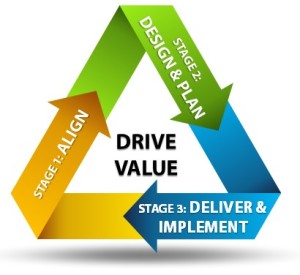Customer advisory boards (CABs) are highly beneficial and effective across the enterprise (impacting sales, marketing, product management, overall strategy, and more). Get it right, and your company will maximize the impact of the board. Get it wrong, and your company won’t see the results or return on investment – and perhaps alienate your customers.
In Part 1 of this blog post, I’ll review customer advisory board best practices in stage 1 (Align) and stage 2 (Design and Plan) of the 3-stage CAB implementation process to help you get it right from the start.
Stage One: Align Your Customer Advisory Board to Corporate Strategic Goals
Internal alignment: The first critical piece of initiating a board begins with internal alignment. Make sure the CAB supports strategic business goals and priorities. What (exactly) do you want to learn from your board? What do you want your customers to learn about your organization, products and services? Do you have a committed executive sponsor? Is the executive sponsor able to commit resources (budget, personnel and time)? Start by interviewing key stakeholders about two-way business objectives and key topics for the CAB.
Roles and responsibilities: Identify your internal sphere of influence: the people that will plan and implement the customer advisory board. Along with the executive sponsor, you’ll need a steering committee of key functional leads, subject matter/ content experts and a core team to drive the board.
Customer advisory board charter document: What are the reciprocal objectives of the board that support your “reason to convene”? What would be the right mission and is there a corresponding theme to engage prospective members? What is the duration of membership? Why would someone join the board? Include member benefits in the charter document. How often will the board meet? Specify participation and travel costs covered. Also include the roles and responsibilities of your internal team.
Stage Two: Design and Plan Your Customer Advisory Board
CAB design elements: Will the board be vertical (a single industry focus) or horizontal (across many industries)? Regional or global? What are the desired dates and location of the initial face-to-face meeting? We highly recommend securing a venue and exact meeting dates to include in recruitment documentation, even though it may be six to 12 months away. Calendars of busy executives are booked far in advance.
CAB scorecard: How will you measure success? Revenue generated? Beta testers? Testimonials? Case studies? Though leadership pieces? Product feedback? Read more about metrics here, here and here.
CAB timeline: Does your team have at least 6 months lead time from CAB initiation to the first face-to-face meeting? Most people underestimate the time and resources required to successfully manage and implement a CAB, making a rushed and substandard program. Importantly, time is needed to ensure the caliber of the peer-to-peer group you are forming.
CAB recruitment: Who will you invite to the board? What is the ideal member profile? How many members do you want to recruit? Is your list of prospective members large enough to recruit a minimum of 15-18 customers? Do you have executives that will recruit assigned prospective members? Have you prioritized or force-ranked the prospective members to invite in waves? Are the members really peers with the same level of responsibility?
Reach out to your sales/ account management team to request nominations. Vet all nominations with your internal sphere of influence team.
Finalize recruitment materials (invitation letter, printed charter document, phone script and instructions for executive recruiters). Train all recruiters on the recruitment process. Start inviting prospective members and fill your advisory board.
Set your customer advisory board up for success by first aligning it to strategic business goals and then thoroughly plan and design the board. Stay tuned for part 2 of this post covering stage 3 of the CAB implementation process, deliver and implement….and the importance of driving ongoing value from your advisory board program.

